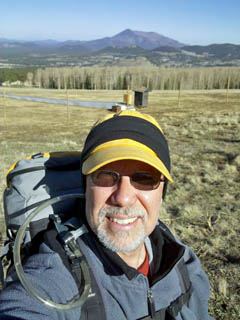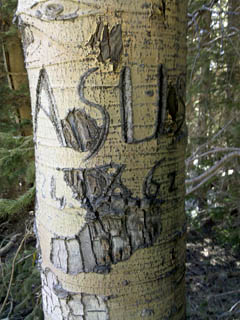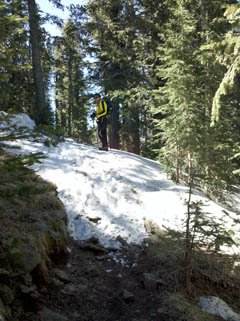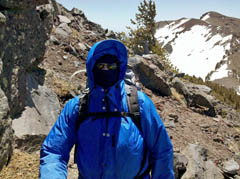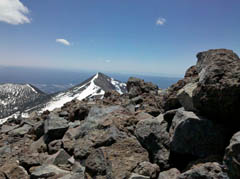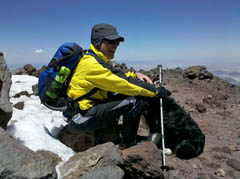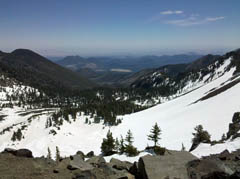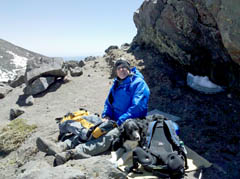|

|

|

|

|

|
|
Wednesday,
April 27, 2011
  Woods
at NAU - I
first encountered the work of Tom
Woods
when I read about the "Great
Depression of 1921." [Or, watch the excellent
video posted up on YouTube, or read Bob
Murphy's account
in the Freeman.] I liked it so much, I used
some of this material as part of my annual contribution to the
Economic Outlook Conference, organized by the business college at
Northern Arizona University (NAU). Woods
at NAU - I
first encountered the work of Tom
Woods
when I read about the "Great
Depression of 1921." [Or, watch the excellent
video posted up on YouTube, or read Bob
Murphy's account
in the Freeman.] I liked it so much, I used
some of this material as part of my annual contribution to the
Economic Outlook Conference, organized by the business college at
Northern Arizona University (NAU).
Then, I fell into the Mises
Academy, an on-line series of courses with an Austrian bent.
Although I had heard of its most famous member - F. A. Hayek - I knew
next to nothing of this school of economic thought. Over the
late spring, summer and fall of 2010, I signed on for six of their
courses. One of the first was a course on the Great Depression,
taught by Tom Woods. I had been using some material on this
subject in my money and banking classes for a couple of years (The
Forgotten Man and Rethinking
the Great Depression). So, this was an excellent opportunity
to add to my knowledge and to learn more of the Austrian
perspective. During the course, the topic of "nullification"
came up, as Woods had just published a book on that subject. He
was also going to be teaching a class on the subject, so I decided to
enroll in that one as well.
It was a great class. It is really a history class, which is
Woods' expertise, and it is difficult for me to branch out beyond
economics, especially in the middle of a school semester, but it was
fascinating. In the late fall of 2010, he spoke at Grand Canyon
University, in Phoenix, and I drove down to see his presentation.
Ever since then, I had thought about getting him to speak at
NAU. But, my enthusiasm waned a bit as the months rolled by and
my attention was diverted to other matters. Then, an Arizona
state senator proposed that a committee be formed, in the legislature,
that would consider whether certain federal laws should be nullified
(which would then go to a vote before the legislature). And,
editorials popped up, along with misinformed letters. So, I was
re-energized, decided to strike while the iron was hot, and made
arrangements for Tom to speak at NAU.
So, on April 6th, he came to town. Before the talk, I arranged
to host him for dinner with some of the students in the NAU
Conservatives (which I serve as the faculty advisor) and my new public
choice class. Pictured above (click to see a bigger image),
clockwise from my empty seat, are Jacob, Shantell, Tom Woods, John,
Beth, Christian, Carolina, Meagan, Rachael and Dustin. It was a
great time and I am sure that all of my students enjoyed this
opportunity to meet with, and talk to, Tom Woods. [They also
liked the fact that I was subsidizing their meal!]
The event was great. About 175 people were in attendance.
I was hoping for more, but that's a good crowd. Bob at Reclaim
Liberty has posted a podcast of the speech! Elisha at the Flagstaff
Liberty Alliance
was active in drumming up support and even staged
a rally out in front of city hall! And, the local paper featured
a very
positive story on the event, on the front page! There were
also a lot of letters and most were positive, which surprised me a
bit. Overall it was a great time, but it did wear me out with
the logistics and arrangements. I think I will content myself to
being a follower while I restore balance to my life!
 Related
blog: Nullification,
AZ
Related
blog: Nullification,
AZ
|
|

|
|
Wednesday,
May 5, 2011
  Atlas
Annoyed
- I
don't know if it is some kind of cosmic joke. If it is, I just
don't get it. I have seen Atlas
Shrugged twice and been sorely disappointed both times. Not
by the content, but by the presentation. I saw it in Phoenix and
couldn't believe that the movie could be so dark. Not in a
figurative manner, but really hard to see. It was like taking a
picture at dusk with your flash turned off. The outdoor shots
were OK, but all of the interior scenes were just hard to see. I
pored over the reviews on the web and came to the conclusion that it
wasn't the film, since nobody else commented on that. Instead, I
figured, it must have been the movie theater. Seeing as how
there was only the one place showing this movie in all of Arizona, it
seems like a shame. Atlas
Annoyed
- I
don't know if it is some kind of cosmic joke. If it is, I just
don't get it. I have seen Atlas
Shrugged twice and been sorely disappointed both times. Not
by the content, but by the presentation. I saw it in Phoenix and
couldn't believe that the movie could be so dark. Not in a
figurative manner, but really hard to see. It was like taking a
picture at dusk with your flash turned off. The outdoor shots
were OK, but all of the interior scenes were just hard to see. I
pored over the reviews on the web and came to the conclusion that it
wasn't the film, since nobody else commented on that. Instead, I
figured, it must have been the movie theater. Seeing as how
there was only the one place showing this movie in all of Arizona, it
seems like a shame.
So, I was prepared to wait until the DVD comes out and then see a
well-renditioned copy of the film. But, then, a local
entrepreneur managed to make arrangements for the film to come to
Flagstaff for a single showing. I went, hoping to get a better
presentation, but, alas, I am starting to shrug something
fierce. I can't say that it was too dark, but being in the
second row may have something to do with my perceptions. But, it
was not sharp and clear. All of the wide shots were made up of
fuzzy little objects. The drive to Wisconsin looked like a
silver smudge moving across the screen. The close ups of the
actors were fine, as the distorting effects were minimized as a
consequence. But, everything else was blurred.
And, then there was this distracting effect of cutting off the tops of
people's heads. In at least a half dozen scenes, there is a
speaking character whose head, above the nose, is completely off
screen. Yikes! Is this just a bad joke? I sure hope
it isn't some kind of artsy-fartsy attempt to make a statement.
If so, it doesn't work. And, I really don't believe that was the
intent.
What am I to conclude? Well, even though there were only 300
copies of the film distributed for theatrical release, I must have
seen a bad copy. I am quite sure that the one I saw in Flagstaff
must be the same one shown in Tempe. And, the theaters compound
the problem with poor projection equipment and lax oversight with
regard to the quality of the product. This isn't the first time
that has happened, but I couldn't be more aware of the seeming irony
given that this film is about how smart and driven people, who make
our lives better in a thousand different ways, are constantly being
degraded and torn down by shallow and incompetent fools.
Apparently, these shallow and incompetent fools are responsible for
producing, distributing and showing this movie. We have seen the
enemy and he is . . . pretending to be one of us!
 On the other hand, this morning I watched a movie I had recorded on my DVR. It was called, "Hunter
Prey," came out just last year (I had never heard of it) and
was being shown in high def on Showtime. With a budget only 3%
as large as Atlas, it was crystal clear, easy to hear and light years
better than what I had just seen on the big screen. And, at 53
inches, watching on my TV is a very acceptable alternative to the big
screen at the theater. Maybe it is just time for me to totally
give up on "going to the movies." Granted there is the
socialization element, and the sound, but there is so much quality
variation that I am just not sure it is worth it. Better to wait
a few months and watch a really good copy of the film. Maybe it
is time for me to return my Harkins
loyalty cup!
On the other hand, this morning I watched a movie I had recorded on my DVR. It was called, "Hunter
Prey," came out just last year (I had never heard of it) and
was being shown in high def on Showtime. With a budget only 3%
as large as Atlas, it was crystal clear, easy to hear and light years
better than what I had just seen on the big screen. And, at 53
inches, watching on my TV is a very acceptable alternative to the big
screen at the theater. Maybe it is just time for me to totally
give up on "going to the movies." Granted there is the
socialization element, and the sound, but there is so much quality
variation that I am just not sure it is worth it. Better to wait
a few months and watch a really good copy of the film. Maybe it
is time for me to return my Harkins
loyalty cup!
I think that a well-lit, well-framed copy of Atlas Shrugged (Part I)
will be great to have and to watch. The theatrical version was a
total blow out. If they really do Parts II and III, I am pretty
sure I'll wait for the DVDs. But, after watching a second time,
I do have one other complaint about the film - Dagny Taggart's heels
were too tall. It took me a while to realize that her clunky
style of walking was due to this fact. But, there is a scene
where we get a close up view of the heels (did I mention that I was in the second
row?) and they must have been 6 inches. Maybe the intent was to
make her real tall and tower above everyone else. Maybe.
But, it really is just impractical for her, and not at all consistent
with how I remember her character from the book. More suitable
for going out clubbing than for a crisis manager. Is this really
any way to run a railroad?
|
|

|
|
Friday,
May 13, 2011
 Good
Copter, Bad Copter
- The National Park Service has released an
Environmental
Impact Statement
(EIS) with regard to overflights at the Grand
Canyon. This process has been going on for years, and I wrote a
blog,
Noisy
Grand Canyon?, in 2006 in response to their original scoping
session. I also wrote an editorial during one of my stints with
the local paper on
natural
quiet, which is the driving force behind this effort to restrict
overflights. The EIS release was accompanied by some open houses
on the topic, and, as usual, Flagstaff was included. So, I
went. At the time I was wrapping up a hiking story for the paper
and asked the editor if he would like an editorial on this overflight
issue. He was interested and, in fact, had already received an
editorial blasting the park service's proposal as being woefully
insufficient. It took a few weeks to get this one done, due to
the crush of my other obligations, but with a comment period open
until June, it wasn't necessary to rush. I submitted it in early
May and it
ran,
side-by-side with the
other
editorial, on Wednesday, May 11: Good
Copter, Bad Copter
- The National Park Service has released an
Environmental
Impact Statement
(EIS) with regard to overflights at the Grand
Canyon. This process has been going on for years, and I wrote a
blog,
Noisy
Grand Canyon?, in 2006 in response to their original scoping
session. I also wrote an editorial during one of my stints with
the local paper on
natural
quiet, which is the driving force behind this effort to restrict
overflights. The EIS release was accompanied by some open houses
on the topic, and, as usual, Flagstaff was included. So, I
went. At the time I was wrapping up a hiking story for the paper
and asked the editor if he would like an editorial on this overflight
issue. He was interested and, in fact, had already received an
editorial blasting the park service's proposal as being woefully
insufficient. It took a few weeks to get this one done, due to
the crush of my other obligations, but with a comment period open
until June, it wasn't necessary to rush. I submitted it in early
May and it
ran,
side-by-side with the
other
editorial, on Wednesday, May 11:
Flights promote
access, diversity
by Dennis Foster
The National Park Service
is currently considering new overflight rules for Grand
Canyon. In general, the proposals are intended to constrain
and regulate the air tour industry in ways that will do
little to improve and enhance the experience of visitors to
this scenic place.
Indeed, considering the
wide array of human interactions with the Grand Canyon, you
would be hard-pressed to find any activity that has less of
an environmental impact than do these overflights. Less than
the visitors to the rim, the hikers below the rim or the
boaters on the river. And, certainly less than the NPS
helicopters that fly below the rim, whose impacts are
excluded from this proposal.
However, the Park Service
has been charged by Congress to restore "natural
quiet" to most of the Grand Canyon. Exactly what this
means is contentious. It doesn't necessarily mean quiet as
you and I would understand it. And, while I would consider
humans as part of nature, that's not what they mean, either.
Suffice to say it really boils down to competition among
various special interests and how they want to control the
Grand Canyon experience.
Among those special
interests are my brothers and sisters in the backpacking
community. You may be surprised to learn that they are a
selfish and greedy lot, who would like to have the Grand
Canyon all to themselves, without the inconvenience of other
people intruding on "their" special place. It
would be a huge mistake to assume that they have some
singular insight about the canyon. If that was true, then my
30-plus years of hiking the canyon would give me more
influence than I have, assuming I have any. I do more than
tolerate the fact that other people will want to experience
the canyon in ways different from me; I embrace this
diversity of experiences, and consider them all equally
valuable to the human condition.
I do not envy the
balancing act that the Park Service has to maintain. I agree
with much of what they have already done - no air tours over
the corridor area, nor over the developed areas of the rims,
nor at the beginning and end of the day. There should be
separation as well as accommodation.
But, their current
proposal goes too far. They want to create seasonal shifts
in the two overflight corridors, closing each for half the
year. And, they want to expand the daily curfews to 15 hours
a day, in the summer, and 17 hours a day, in the winter.
These particular
restrictions will have the effect of increasing the
congestion along the overflight corridors, potentially
doubling the traffic on those routes when they are open.
When I quizzed an official at the open house about this
point, they seemed surprised by this simple math.
Further, the imposition of
a daily cap and the raising of the minimum elevation level
in the flight-free zones appear to be solutions in search of
a problem, and without any but the most arbitrary of
reasoning.
More troubling is the
bureaucratic mandate of so-called "quiet
technology" within 10 years. Wouldn't it be nice if the
government could just wave a magic wand and make aircraft
quiet? I don't know anyone who is opposed to such
technology, but the question is always going to be one of
costs and whether the tradeoffs make it a worthwhile
proposition. I am content to let the market determine the
extent and pace of the introduction of such technology,
rather than some bureaucracy.
In the Draft Environmental
Impact Statement, Alternative A is identified as the
"No Action" alternative. That is a bit of a
misnomer, as it leads to "substantial restoration of
natural quiet ... over ... 53 percent of the park."
That meets the Congressional mandate and should be
acceptable to everyone until we revisit the issue again in
2021.
Dennis Foster has a
Ph.D. in economics, has hiked the Grand Canyon since 1977,
has testified before a congressional committee on Grand
Canyon management issues and has taken two helicopter tours
of the Canyon.
|
I
think that my commentary speaks for itself and doesn't need any
elaboration. The other editorial, by Deanna Wulff, really seemed
to make my point. She was all about banning helicopters because
they intrude on her ability to enjoy solitude in the canyon. Her
tone and opinion didn't surprise me, but I will make a few comments
nonetheless:
 Solitude
at night. She
relates her experience of being ill-prepared for her first hike in the
canyon and spending a night "under the gentle moonlight" in
"quiet solitude." OK, I get it. And, I have lots
of cool experiences with the quiet that fills up the space at
night. But, that isn't going to change. There are no
overflights (of the touring variety) allowed from one hour before
sunset to one hour after sunrise. [The current EIS wants to push
that to a couple of hours.]
Solitude
at night. She
relates her experience of being ill-prepared for her first hike in the
canyon and spending a night "under the gentle moonlight" in
"quiet solitude." OK, I get it. And, I have lots
of cool experiences with the quiet that fills up the space at
night. But, that isn't going to change. There are no
overflights (of the touring variety) allowed from one hour before
sunset to one hour after sunrise. [The current EIS wants to push
that to a couple of hours.]
 The
entitlement problem. She
writes that she "moved to Flagstaff, so I could hike in the Grand
Canyon . . . Unfortunately, I discovered the assault of a flyover
zone." So, we can establish that these overflights came
before Ms. Wulff arrived, yet she seems quiet comfortable imposing her
view of what is acceptable, and unacceptable. Although I have
labeled this the "entitlement problem," perhaps I should
have labeled it the "arrogance problem."
The
entitlement problem. She
writes that she "moved to Flagstaff, so I could hike in the Grand
Canyon . . . Unfortunately, I discovered the assault of a flyover
zone." So, we can establish that these overflights came
before Ms. Wulff arrived, yet she seems quiet comfortable imposing her
view of what is acceptable, and unacceptable. Although I have
labeled this the "entitlement problem," perhaps I should
have labeled it the "arrogance problem."
 The
flyover zone. The
uninformed reader will probably think that helicopters fly over the
entire canyon all the time. Of course, they don't. They
have two specific flyover zones and Ms. Wulff doesn't acknowledge that
one can
The
flyover zone. The
uninformed reader will probably think that helicopters fly over the
entire canyon all the time. Of course, they don't. They
have two specific flyover zones and Ms. Wulff doesn't acknowledge that
one can  seek
out fantastic hiking opportunities elsewhere in the canyon out of
earshot of these helicopters. But, not necessarily out of
earshot of all helicopters. Pictured to the right is a park
service helicopter flying way outside of these zones which we
encountered on our recent hike through "the gems." It
was searching for an ultralight vehicle and its pilot that went
missing a couple of days before our hike began. We saw it fly up
and down the canyon once, or twice, each of the first three days of
our hike. [Go see a map
of the areas searched by air!] This kind of noise is not
included in the EIS. At the open house I attended, an official
told me, "It is a matter of health and safety." Well,
I can't argue with that, having been the recipient
of just such a health and safety visit. But, I think it is disingenuous to
restrict the "noise" of the commercial overflights when
there is noise from these NPS flights. seek
out fantastic hiking opportunities elsewhere in the canyon out of
earshot of these helicopters. But, not necessarily out of
earshot of all helicopters. Pictured to the right is a park
service helicopter flying way outside of these zones which we
encountered on our recent hike through "the gems." It
was searching for an ultralight vehicle and its pilot that went
missing a couple of days before our hike began. We saw it fly up
and down the canyon once, or twice, each of the first three days of
our hike. [Go see a map
of the areas searched by air!] This kind of noise is not
included in the EIS. At the open house I attended, an official
told me, "It is a matter of health and safety." Well,
I can't argue with that, having been the recipient
of just such a health and safety visit. But, I think it is disingenuous to
restrict the "noise" of the commercial overflights when
there is noise from these NPS flights.
 The
world is full of noise. Well,
sure, but she infers that there is no quiet anywhere. Quite
absurd. Here in Flagstaff, a short drive can take you to
innumerable quiet locales. And, with great scenery to
boot. And, that is true even in the big city. I used to
live in Honolulu. On the weekends I would hike up the Manoa
Falls trail and it didn't take long to feel like you were light
years from civilization. That has been true pretty much anywhere
I have lived. Ms. Wulff's characterization is just exaggerated
ranting and raving.
The
world is full of noise. Well,
sure, but she infers that there is no quiet anywhere. Quite
absurd. Here in Flagstaff, a short drive can take you to
innumerable quiet locales. And, with great scenery to
boot. And, that is true even in the big city. I used to
live in Honolulu. On the weekends I would hike up the Manoa
Falls trail and it didn't take long to feel like you were light
years from civilization. That has been true pretty much anywhere
I have lived. Ms. Wulff's characterization is just exaggerated
ranting and raving.
 The
wishes of the one versus many. You
couldn't find a more apt example of the desires of the few (hikers)
trying to overwhelm the desires of the many (tourists). Yet, Ms.
Wulff asks, "Should an individual have the right to fly over the
Grand Canyon at the detriment to everyone else?" She has
the question phrased backwards. It should be, does she have the
right to an absolutely quiet Grand Canyon to the detriment of the
thousands that also want to see its majesty and beauty?
Apparently, the answer is, "Yes."
The
wishes of the one versus many. You
couldn't find a more apt example of the desires of the few (hikers)
trying to overwhelm the desires of the many (tourists). Yet, Ms.
Wulff asks, "Should an individual have the right to fly over the
Grand Canyon at the detriment to everyone else?" She has
the question phrased backwards. It should be, does she have the
right to an absolutely quiet Grand Canyon to the detriment of the
thousands that also want to see its majesty and beauty?
Apparently, the answer is, "Yes."
 An
arrogant philosophy. She
ends by claiming that, "[t]he
park should be approached with reverence." Says who?
Says her, and others of her ilk. And, does that make her
right? No, it only makes her arrogant. She can enjoy the
park in solitude if she is willing to work at it. She is being accommodated
by the current rules imposed on overflights. But, that just
doesn't seem to be enough for her.
An
arrogant philosophy. She
ends by claiming that, "[t]he
park should be approached with reverence." Says who?
Says her, and others of her ilk. And, does that make her
right? No, it only makes her arrogant. She can enjoy the
park in solitude if she is willing to work at it. She is being accommodated
by the current rules imposed on overflights. But, that just
doesn't seem to be enough for her.
|
|

|
|
Wednesday,
May 18, 2011
 A
Quiet Mt. Humphreys?
- This past weekend, hiking buddy John Eastwood, his new dog,
Buddy, and I took a trek up Mt. Humphreys, the highest point in
Arizona (12,600+ feet). We could see snow on the peaks, but
thought we'd make it to the top without much trouble. I did
bring along a pair of Kahtoolas, and, in retrospect, John should have
as well. We mostly encountered snow along the shady,
northerly-facing part of the trail that winds its way through the
forest. There, we were often trekking across packed snow that
was 3 to 4 feet above the trail. It was cold, and everything was
quite solid on the way up. We left the lower parking area at the
Snowbowl
Ski Area
at 7:45 a.m. and headed up alongside the chair lift,
until we reached a road. From there, we followed a ridge up
until we met the trail. So, we cut off some snowy sections, but
we still had quite a bit to cover before popping out onto a
southerly-facing section that then climbs above the tree line and to a
saddle, between Humphreys and Agassiz, where there is a good resting
spot out of the elements. A
Quiet Mt. Humphreys?
- This past weekend, hiking buddy John Eastwood, his new dog,
Buddy, and I took a trek up Mt. Humphreys, the highest point in
Arizona (12,600+ feet). We could see snow on the peaks, but
thought we'd make it to the top without much trouble. I did
bring along a pair of Kahtoolas, and, in retrospect, John should have
as well. We mostly encountered snow along the shady,
northerly-facing part of the trail that winds its way through the
forest. There, we were often trekking across packed snow that
was 3 to 4 feet above the trail. It was cold, and everything was
quite solid on the way up. We left the lower parking area at the
Snowbowl
Ski Area
at 7:45 a.m. and headed up alongside the chair lift,
until we reached a road. From there, we followed a ridge up
until we met the trail. So, we cut off some snowy sections, but
we still had quite a bit to cover before popping out onto a
southerly-facing section that then climbs above the tree line and to a
saddle, between Humphreys and Agassiz, where there is a good resting
spot out of the elements.
And, elements we did have! The saddle is at about 11,500 feet
and John had seen a weather forecast for 50+ mph winds at that
elevation, with a daytime high of only 35 degrees. It was very
windy over the whole trip and especially so as we neared the
summit. That got me to thinking about the whole "natural
quiet" issue, about which I just blogged
with regard to the Grand Canyon. You see, that phrase does not
mean quiet, even though advocates imply that to be the case. It
really means that all the noise you hear is not man-made. And,
today we had lots of noise. So much so, that it was hard to hear
each other even when yelling. At the summit, we guestimated that
the winds were blowing upwards to twice has hard as we had been
experiencing. Maybe that would make it about 70 mph. It
felt like we could easily blow over the side, which causes one to
crouch down low and take steps with great care. I determined
that if the wind is able to blow your hiking pole sideways, it's
blowing too hard! We stayed at the top for hardly ten
minutes. I was reluctant to taking off my pack and dig around
for something to eat. I just didn't trust that something might
blow away, into the Inner Basin.
I did get a chance to pull out my phone and send a photo to friends
and family. But, even just taking off my gloves for a couple of
minutes practically gave me frostbite! Not the cold so much as
the wind. I wore my balaclava from the saddle to the summit, and
then back down to the saddle. Brrr. Once back to the
saddle, we grabbed a spot that is always leeward here and had
something to eat and rested for the better part of an hour.
Coming back down, we decided to make an earlier departure from the
trail, to avoid all the snowpacked sections, or, at least, many of
them. So, we reached a switchback and started down. We
were quite successful at this, and hardly had to cross any snowy
areas. Indeed, we were usually following some multi-colored
ribbons that someone had strung up in the trees, perhaps to mark this
more direct route through the woods.
It was a long day. We started at 7:45
a.m., reached the summit at about 12 noon, were back down to the
saddle at 1:15 p.m., where we rested until 2 o'clock. Then, we
packed up and headed down the trail, reaching John's truck at about
4:30 p.m. It was a nice hike for me, even if it did take all
day. It is the first significant hike I have done without my neoprene
knee sleeve in over a year. It felt good and I look forward
to more hikes this summer.
|
|

|
|
Wednesday,
June 18, 2011
 Wilderness
Bull
- The
National Park Service is beginning the process of revising its Backcountry
Management Plan for Grand Canyon. They held a
"scoping" session on the campus of NAU and I went to look
over their material. As I was considering their proposals (which
are only tentative as of now), I was struck by how convoluted and
contorted their plans were and I realized that this was all due to one
key issue - most of the land in the park is "proposed" for
wilderness designation in accord with the 1964
Wilderness Act, and the NPS manages those lands accordingly, even
though Congress hasn't made any decision in this regard. So, I
asked the editor of the local paper, the Arizona Daily Sun, if he
would be interested in a guest editorial on the issue of wilderness,
as opposed to me writing something about the backcountry plan
itself. He was, and I did. Surprisingly, I sent it off a
bit after noon on Wednesday, June 8 and he ran
it the very next day, and he used my title, which is
unusual. Here it is: Wilderness
Bull
- The
National Park Service is beginning the process of revising its Backcountry
Management Plan for Grand Canyon. They held a
"scoping" session on the campus of NAU and I went to look
over their material. As I was considering their proposals (which
are only tentative as of now), I was struck by how convoluted and
contorted their plans were and I realized that this was all due to one
key issue - most of the land in the park is "proposed" for
wilderness designation in accord with the 1964
Wilderness Act, and the NPS manages those lands accordingly, even
though Congress hasn't made any decision in this regard. So, I
asked the editor of the local paper, the Arizona Daily Sun, if he
would be interested in a guest editorial on the issue of wilderness,
as opposed to me writing something about the backcountry plan
itself. He was, and I did. Surprisingly, I sent it off a
bit after noon on Wednesday, June 8 and he ran
it the very next day, and he used my title, which is
unusual. Here it is:
|
Is
“Wilderness” Necessary in Grand Canyon?
Dennis Foster
Imagine
biking along the road from the iconic Desert View Watchtower
to Cape Solitude, stopping periodically to soak up the vast
panorama of the Grand Canyon from atop the Palisades of the
Desert.
Imagine
driving along the Boundary Road, west of the Grand Canyon
Village, in order to hike out to Mescalero Point or Piute
Point or to the natural arch at Jicarilla Point.
Imagine
driving out to Francois Matthes Point in order to camp
overnight on the north rim overlooking Cheyava Falls, the
highest waterfall in Grand Canyon.
Imagine
all you want, but none of these activities is permitted at
Grand Canyon National Park. That’s because park
officials want some 94% of the canyon’s 1.2 million acres to
be considered as “wilderness” and managed according to the
requirements set out in the 1964 Wilderness Act.
That
probably sounds pretty benign. After all, who could be
against wilderness? Well, I am. Such a designation
requires an act of Congress. It mandates virtually no
human presence, and certainly nothing permanent. It
prohibits any kind of mechanical conveyance, including
bicycles. And, any changes would require another act of
Congress.
Congress
has not voted to make any of Grand Canyon “wilderness.”
No president, since Nixon, has forwarded a recommendation to
Congress asking for Grand Canyon lands to become wilderness,
nor has any Interior Secretary make such a recommendation to
the President since 1971. Both of these steps are part
of the protocol established by the Wilderness Act.
Yet, the
park service has determined, as part of its own internal
policy, that “proposed wilderness … will be managed to
preserve their wilderness character and values undiminished
until Congress acts on the recommendations.” The fact
that Congress has not acted on these proposals for nearly 40
years has become irrelevant to this management decision.
But, that
means the park service can really operate beyond the law and
treat lands as wilderness just because they want to.
Even if Congress rejected such a proposal, I suspect a new
proposal would be made and they’d continue with business as
usual.
Applying
wilderness designation to national park land is excessive.
These lands are already well protected. While the
Wilderness Act includes national parks, it seems more focused
on other lands. Indeed, there are numerous wilderness
areas astride the Grand Canyon, including Kanab Creek, Saddle
Mountain and Paria Canyon. Near to Flagstaff there are
the wilderness areas of Kendrick Mountain, Kachina Peaks,
Munds Mountain and Sycamore Canyon. Altogether nearly 5%
of the United States is in wilderness areas. Arizona has
some 90 such wilderness areas. The Grand Canyon does not
need to have a “wilderness” designation in order to meet
its mandate to preserve its character for future generations.
In July,
the Grand Canyon is getting a new Superintendent, Dave
Uberuaga. It appears that he may be at the canyon for
many years to come. He also appears to be receptive to
the idea that we don’t need to close up the canyon to
preserve it. I would encourage Superintendent Uberuaga
to consider having the park withdraw its recommendation for
wilderness designation and return us to an era of responsible
management where we can accommodate the visitor experience
without loss of the park’s values.
Perhaps
then we can do more than imagine camping overnight on an
isolated north rim viewpoint, or access remote parts of the
canyon without having to hike across miles and miles of
forests, or riding a bicycle out to Cape Solitude.
Perhaps we may even come to do more than imagine a
reestablished Hermit Camp, catering to hikers as it did a
century ago.
Dennis
Foster has a Ph.D. in Economics and has many hiked thousands
of miles in the wilderness areas of Grand Canyon since 1977.
|
I
was able to do pretty much all I wanted with this editorial. I
probably could have made a stronger pitch to the new incoming
superintendent, but he hasn't even gotten here yet! The web
responses were interesting and many were supportive.
I was kind of surprised that some people
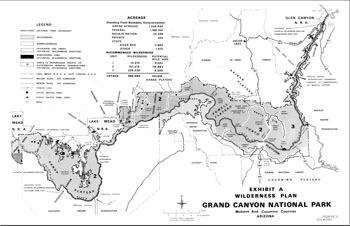 get
the idea that the park doesn't need wilderness designation to be
managed that way. And, I really hate the idea that it would take
an act of Congress to allow bicycles on the Cape Solitude road. get
the idea that the park doesn't need wilderness designation to be
managed that way. And, I really hate the idea that it would take
an act of Congress to allow bicycles on the Cape Solitude road.
To the right is the current map the park is using that shows their
proposed wilderness areas. It is linked to the 2010 update on
their proposed wilderness document. The map doesn't show the
existing wilderness areas around the park and only identifies some of
the other lands without any context. For example, the lands to
the east are Navajo and the tribe doesn't allow any development there.
A few readers took issue with the fact that I am an economist.
It shows how little most people know about the subject. Perhaps
that will be the subject of a later editorial?
My editorial triggered a responding guest editorial, "Grand
Canyon a deserving wilderness," authored by some local
environmentalists. Their editorial lays out some of the facts
and issues surrounding the wilderness issue, but didn't address my
contention that it is unnecessary in order for the park to manage
these lands in this way.
|
|

|
|
Thursday,
June 30, 2011
 Backcountry
Plan 2¢
- The
National Park Service was soliciting comments for their revision of the
backcountry management plan for Grand Canyon. I previously
blogged on the bigger picture here, Wilderness
Bull. But, with the deadline finally arriving (Monday, June
27), I did post off the following comment on-line: Backcountry
Plan 2¢
- The
National Park Service was soliciting comments for their revision of the
backcountry management plan for Grand Canyon. I previously
blogged on the bigger picture here, Wilderness
Bull. But, with the deadline finally arriving (Monday, June
27), I did post off the following comment on-line:
|
Grand
Canyon Backcountry Management Plan
Comments submitted on 6/27/2011
First and
foremost, the park needs to reassess its wilderness policy.
Rim access to remote parts of the canyon should not be made
more difficult, as has been the case for many years. For
example:
1.
Motorized and non-motorized access to Cape Solitude.
Maybe some parts of the year can be reserved for hiking only,
or for hiking & bikes only, but some accommodation should
be made here. It would be insane to hike out here in the
middle of July, so why not allow vehicles then?
2.
Motorized access along the boundary road. It used to be
open to the public, and getting to it is not especially easy,
so why not leave it open? Paying $25 to drive through
1.5 miles of Havasupai lands is just extortion.
Superintendent Alston told me that the park was considering
clearing the old road from Dodd Tank to Lauzon Tank to Pasture
Wash. That would be an improvement, although the whole
boundary road should be open.
3. Years
ago I got a permit to camp at Francois Matthes Pt., on the
north rim. My dad and I drove out there and had a great
time. Today, you can't drive out there. Why?
You also can't drive out to Tiyo Pt. (so I am told).
Why? What is the point of closing off these roads?
By keeping people away, what have you accomplished?
Explain this! And, don't say you're doing this to
preserve the park for future generations, because it seems
clear that the intent is to close these areas off permanently,
so nobody gets to enjoy them.
The new
plan should do more to create and maintain mid-level use area
in the canyon. A full-fledged campground at Hermits
would be a start, along with some major improvements to
camping sites between there and Indian Garden.
Cottonwood campground is often "sold out" during
popular times and could be easily expanded.
All the
inner canyon campgrounds should be market priced, and probably
the best way to do that is by privatizing their operations
(with different owners!!!!).
Current
party limitations in more remote areas are absurd.
Letting two solo hikers monopolize Nankoweap is untenable.
It would be better to impose and number limit, than a party
limit. This past spring, my 3-person group was permitted
for the same areas along the gems as an 8 party group and
guess what? We were on exactly the same itinerary for 3
days, with all of us camping together in Ruby and Slate (the
third day, we decided to camp atop the Redwall on the Boucher
trail rather than at Boucher creek). I would also allow
people to buy up slots if they really want a solitary
experience (maybe on a rising scale; say $5 for the 1st slot,
$10 for the 2nd, and so on).
Toilet
facilities can be dramatically improved in a lot of sensitive
areas, and that doesn't mean the awful tank toilets.
From Glen Canyon Dam to Lees Ferry there are fantastic
facilities, maintained by the concessionaire. It seems
to me the same could be done in Grand Canyon at many crucial
places - South Canyon, Nankoweap, Little Colorado, Tanner,
Hance, Clear Creek, to name but a few. Given that they
are along the river, those users (and hikers) could have a fee
that goes to their maintenance. Also, for areas away
from the river, or where hikers predominate, charge more for
camping and provide better facilities (Horseshoe Mesa, Hermit,
et al.). The addition of the toilet at the 1.5 Mile
house on the BA Trail many years ago still strikes me as
having taken a remarkably long time to accomplish! The
ones at the 3 mile house and at the river were long overdue,
and make for that much better of an experience.
With
regard to backpacking permits, I would suggest consideration
of a three tiered system, as follows:
Tier 1: Permits for designated camping spots in the
Corridor and Threshold use areas.
Tier 2: Permits for open camping in Primitive areas.
Tier 3: No specific permits necessary for Wild areas.
Require that backpackers file an itinerary with the park
(obtaining whatever permits are needed for Tiers 1 & 2).
If use rises dramatically, a wild area can be changed to a
Primitive area.
Revise the
permitting process. The fact that it has devolved into a
random draw based on fax arrival times is a signal that
something is terribly wrong here!
Finally,
some have suggested the introduction of predators into the
wilderness areas of the Grand Canyon - wolves and bears.
Please, don't do it. Then, I'll have to start hiking
with a gun, and I don't want to have to do that! It is
an example of the "law of unintended consequences."
Thank you
for considering my comments.
|
Yes,
I do use too many exclamation marks. But, since they mostly ignore
whatever I have to say, I suppose I feel like the added emphasis might
actually pay off. OK, probably not.
|
|

|

|

|

|

|





 seek
out fantastic hiking opportunities elsewhere in the canyon out of
earshot of these helicopters. But, not necessarily out of
earshot of all helicopters. Pictured to the right is a park
service helicopter flying way outside of these zones which we
encountered on our recent hike through "the gems." It
was searching for an ultralight vehicle and its pilot that went
missing a couple of days before our hike began. We saw it fly up
and down the canyon once, or twice, each of the first three days of
our hike. [Go see a
seek
out fantastic hiking opportunities elsewhere in the canyon out of
earshot of these helicopters. But, not necessarily out of
earshot of all helicopters. Pictured to the right is a park
service helicopter flying way outside of these zones which we
encountered on our recent hike through "the gems." It
was searching for an ultralight vehicle and its pilot that went
missing a couple of days before our hike began. We saw it fly up
and down the canyon once, or twice, each of the first three days of
our hike. [Go see a 